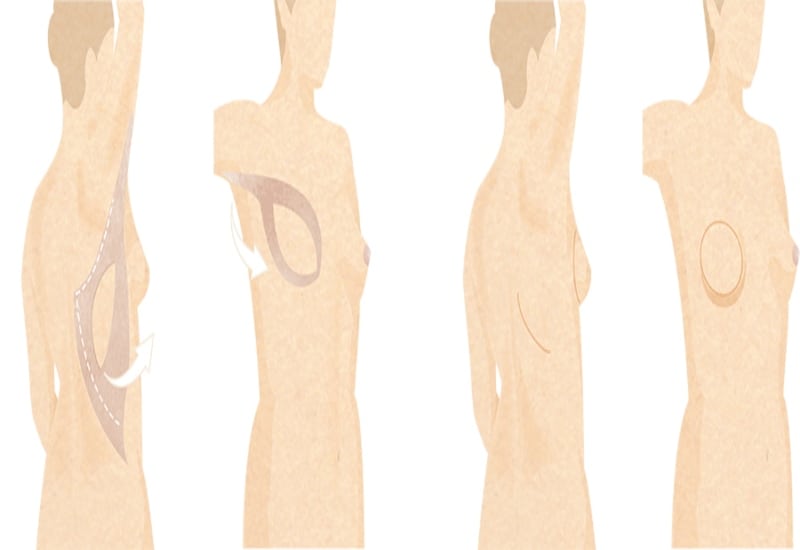Latissimus Surgery in Surrey, BC
Latissimus Dorsi Flap Breast Reconstruction
Latissimus dorsi flap reconstruction is most commonly used to recreate a breast following mastectomy for cancer, but may also be used to correct significant breast asymmetry, or congenital problems such as tuberous breast deformity. This procedure involves taking muscle, overlying skin and fat from your back and transplanting it to your chest to recreate the breast shape. For breast cancer patients, it can be done at the time of mastectomy (immediate) or at a later date (delayed). It can be used for breast reconstruction on its own or combined with an implant underneath it for more volume.
When Is the Latissimus Dorsi Flap Breast Reconstruction Used?
The latissimus dorsi flap is commonly used in women who have had radiation to the chest to replace the radiated, unhealthy tissue with healthy skin, fat, and muscle. It can also be used to cushion and protect an underlying breast implant. For single sided reconstructions, some women may also choose to have a reduction or breast lift on the other side to help improve final symmetry.

Good Candidates
The latissimus dorsi flap could be a good choice for you if you:
- Don’t have enough extra abdominal tissue to make a breast
- Need to add volume over or protect an implant
- Want to replace chest wall skin/tissue that is unhealthy from radiation
Advantages
- Can bring in healthy tissue to replace radiation chest tissue
- Can provide protection and minimize scarring surrounding an implant
- Is versatile at addressing partial breast defects
Disadvantages
- Involves limited tissue volume which may necessitate an implant to achieve symmetry
- Results in donor site scar along back
- Creates asymmetry of back silhouette (more obvious in muscular women)
- May weaken shoulder function (e.g. for climbing, rowing, pulling, using crutches)
Preparing for Surgery
If you are a smoker, you should try to quit before surgery, as the risks of complications are higher in smokers. You should stop taking all over-the-counter pain or fever medicines (except Tylenol) and blood thinners for two weeks prior to your procedure. Many herbal medicines can also cause bleeding and also need to be stopped before surgery, such as ginkgo biloba, St. John’s Wort, and high doses of fish oil, flax seed oil, or vitamin E.
Possible Complications
As in any surgery, risks include anesthetic reaction, infection, scarring, poor wound healing, bleeding, or seroma (fluid collection). Complications specific to this surgery are mastectomy flap necrosis (skin slough), partial flap loss, fat necrosis (firm scar lumps in the breast), deep vein thrombosis or pulmonary embolus (clots-very rare) numb skin, breast asymmetry, or the need for revisional surgeries.
Contact Us
To learn more about how you may benefit from latissimus dorsi flap reconstruction or to schedule a consultation with one of our board-certified plastic surgeons, please contact our Surrey office today.
Recovery from Latissimus Dorsi Flap Reconstruction Surgery
The chest and back often ache and feel bruised for a couple of weeks. Your doctor will prescribe painkillers to help with the pain and antibiotics to prevent infection.
You will have a drain under the breast and in the back after surgery. Your surgeon usually removes these in the office within 1-2 weeks after surgery. You cannot shower as long as you have drains in place. It is common for patients to need to keep a bandage over the incision for comfort and to collect any small bits of drainage for the first 1-2 weeks after surgery until the incisions have healed. Most sutures will be absorbable.
The exact recovery can vary considerably and often depends on your health and fitness before surgery, the extent of the surgery and cancer, whether it was an immediate or delayed reconstruction and the need for radiation and chemotherapy after surgery. Some women find they can return to work within a couple of weeks, though most take an extended leave to help recover physically and mentally from the cancer therapy. Most patients are back to doing most activity by six weeks but it can take 6-12 months to fully recover after the surgery.
Nipple reconstruction and tattooing is commonly done 3-6 months later under local anesthetic. It will be six months to a year before your breasts settle into their new shape and for the scars to become less obvious.
